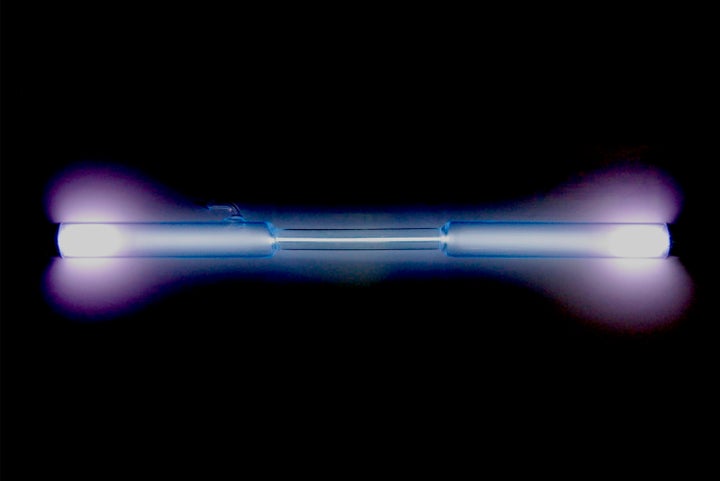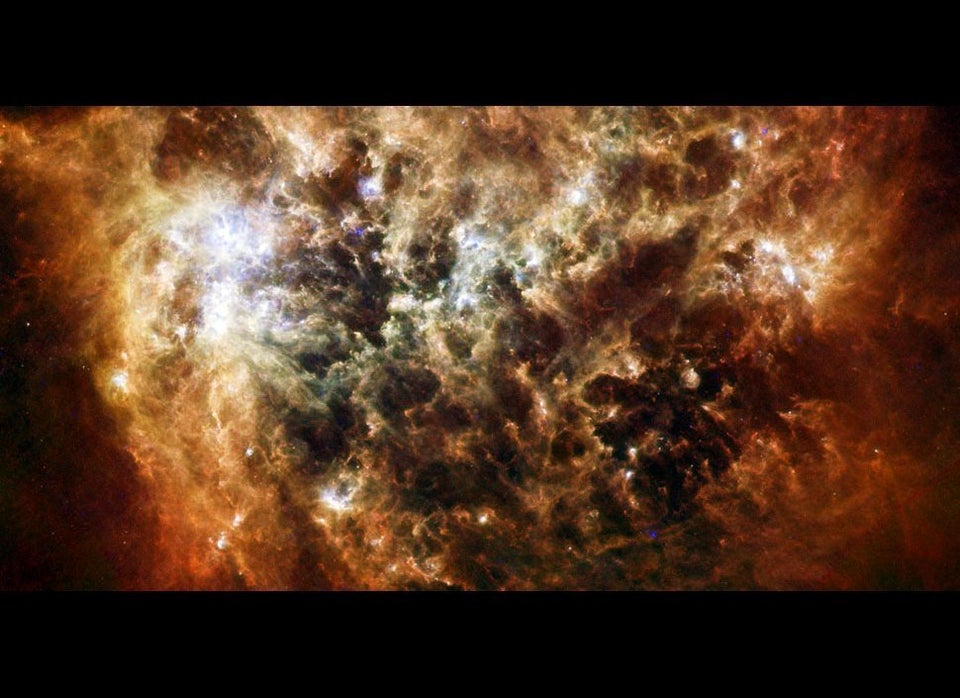By Ewen Callaway and Nature magazine
The evidence is in every breath of air, but answers are harder to come by. Xenon, the second heaviest of the chemically inert noble gases, has gone missing. Our atmosphere contains far less xenon, relative to the lighter noble gases, than meteorites similiar to the rocky material that formed the Earth.
The missing-xenon paradox is one of science’s great whodunits. Researchers have hypothesized that the element is lurking in glaciers, minerals or Earth’s core, among other places.
“Scientists always said the xenon is not really missing. It’s not in the atmosphere, but it’s hiding somewhere,” says inspector, sorry, professor Hans Keppler, a geophysicist at the University of Bayreuth in Germany. He and his colleague Svyatoslav Shcheka are the latest geoscientists to tackle the case, in a report published today in Nature.
Elementary, my dear Watson
They went looking for answers in minerals. Magnesium silicate perovskite is the major component of Earth’s lower mantle — the layer of molten rock between the crust and the core, which accounts for half the planet’s mass. The sleuthing scientists wondered whether the missing xenon could be squirreled away in pockets in this mineral. “I was quite sure that it must be possible to stuff noble gases into perovskite,” says Keppler. “I suspected xenon may be in there.”
The researchers tried dissolving xenon and argon in perovskite at temperatures exceeding 1,600 ºC and pressures about 250 times those at sea level. Under these extreme conditions — similar to those in the lower mantle — the mineral sopped up argon yet found little room for xenon.
Those results may sound disappointing, but they gave Keppler and Shcheka an idea. What if xenon isn’t hiding at all?
More than 4 billion years ago, Earth was molten. Meteorites bombarded the planet, causing it to lose much of its primordial atmosphere. Keppler and Shcheka suggest that argon and the other noble gases hid in perovskite, but most of the xenon could not dissolve in the mineral, and disappeared into space.
“This is completely different from what everybody else is saying. They are saying the xenon is here but it's hiding somewhere. We are saying it is not here because very early in Earth’s history it had no place to hide,” says Keppler.
When Earth cooled, argon and other noble gases started seeping out of the perovskite and filling the atmosphere. Xenon, dissolved in the mineral at only trace levels, could in turn make up only trace amounts of the atmosphere.
As further support for their hypothesis, the scientists point out that the relative ratios of three noble gases — xenon, krypton and argon — in the atmosphere roughly correspond to their solubility in perovskite.
The theory may also explain why lighter isotopes of xenon are even more depleted from the atmosphere than heavier ones. “Nobody has ever been able to explain this,” says Keppler. He and Shcheka suggest that over billions of years, when xenon was seeping into space, lighter isotopes were most likely to escape.
Not so fast, says Chrystele Sanloup, a geoscientist at Pierre and Marie Curie University in Paris: “I don't think this discovery accounts for the missing xenon.” She notes that the theory does not totally explain all of the excess heavy xenon in the atmosphere, nor for additional xenon made from the radioactive decay of uranium and plutonium in rocks.
Besides, any explanation for Earth’s missing xenon should also apply to Mars, where the atmosphere also has a dearth of the noble gas. Keppler and Shcheka suggest that here, too, the ancient xenon escaped into space: the planet’s puny gravitational field prevented it from holding onto the gas. As a result, all xenon currently found on Mars is what little could dissolve in perovskite.
Our 2024 Coverage Needs You
It's Another Trump-Biden Showdown — And We Need Your Help
The Future Of Democracy Is At Stake
Our 2024 Coverage Needs You
Your Loyalty Means The World To Us
As Americans head to the polls in 2024, the very future of our country is at stake. At HuffPost, we believe that a free press is critical to creating well-informed voters. That's why our journalism is free for everyone, even though other newsrooms retreat behind expensive paywalls.
Our journalists will continue to cover the twists and turns during this historic presidential election. With your help, we'll bring you hard-hitting investigations, well-researched analysis and timely takes you can't find elsewhere. Reporting in this current political climate is a responsibility we do not take lightly, and we thank you for your support.
Contribute as little as $2 to keep our news free for all.
Can't afford to donate? Support HuffPost by creating a free account and log in while you read.
The 2024 election is heating up, and women's rights, health care, voting rights, and the very future of democracy are all at stake. Donald Trump will face Joe Biden in the most consequential vote of our time. And HuffPost will be there, covering every twist and turn. America's future hangs in the balance. Would you consider contributing to support our journalism and keep it free for all during this critical season?
HuffPost believes news should be accessible to everyone, regardless of their ability to pay for it. We rely on readers like you to help fund our work. Any contribution you can make — even as little as $2 — goes directly toward supporting the impactful journalism that we will continue to produce this year. Thank you for being part of our story.
Can't afford to donate? Support HuffPost by creating a free account and log in while you read.
It's official: Donald Trump will face Joe Biden this fall in the presidential election. As we face the most consequential presidential election of our time, HuffPost is committed to bringing you up-to-date, accurate news about the 2024 race. While other outlets have retreated behind paywalls, you can trust our news will stay free.
But we can't do it without your help. Reader funding is one of the key ways we support our newsroom. Would you consider making a donation to help fund our news during this critical time? Your contributions are vital to supporting a free press.
Contribute as little as $2 to keep our journalism free and accessible to all.
Can't afford to donate? Support HuffPost by creating a free account and log in while you read.
As Americans head to the polls in 2024, the very future of our country is at stake. At HuffPost, we believe that a free press is critical to creating well-informed voters. That's why our journalism is free for everyone, even though other newsrooms retreat behind expensive paywalls.
Our journalists will continue to cover the twists and turns during this historic presidential election. With your help, we'll bring you hard-hitting investigations, well-researched analysis and timely takes you can't find elsewhere. Reporting in this current political climate is a responsibility we do not take lightly, and we thank you for your support.
Contribute as little as $2 to keep our news free for all.
Can't afford to donate? Support HuffPost by creating a free account and log in while you read.
Dear HuffPost Reader
Thank you for your past contribution to HuffPost. We are sincerely grateful for readers like you who help us ensure that we can keep our journalism free for everyone.
The stakes are high this year, and our 2024 coverage could use continued support. Would you consider becoming a regular HuffPost contributor?
Dear HuffPost Reader
Thank you for your past contribution to HuffPost. We are sincerely grateful for readers like you who help us ensure that we can keep our journalism free for everyone.
The stakes are high this year, and our 2024 coverage could use continued support. If circumstances have changed since you last contributed, we hope you'll consider contributing to HuffPost once more.
Already contributed? Log in to hide these messages.

